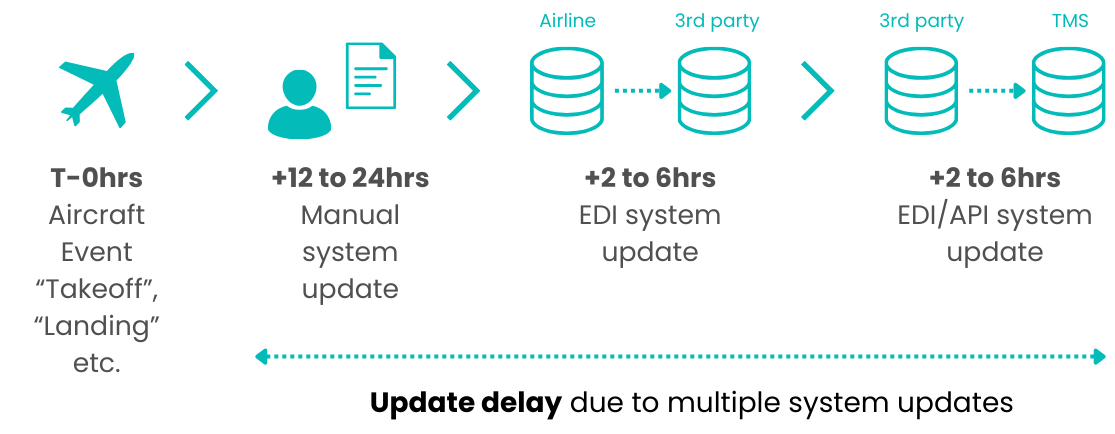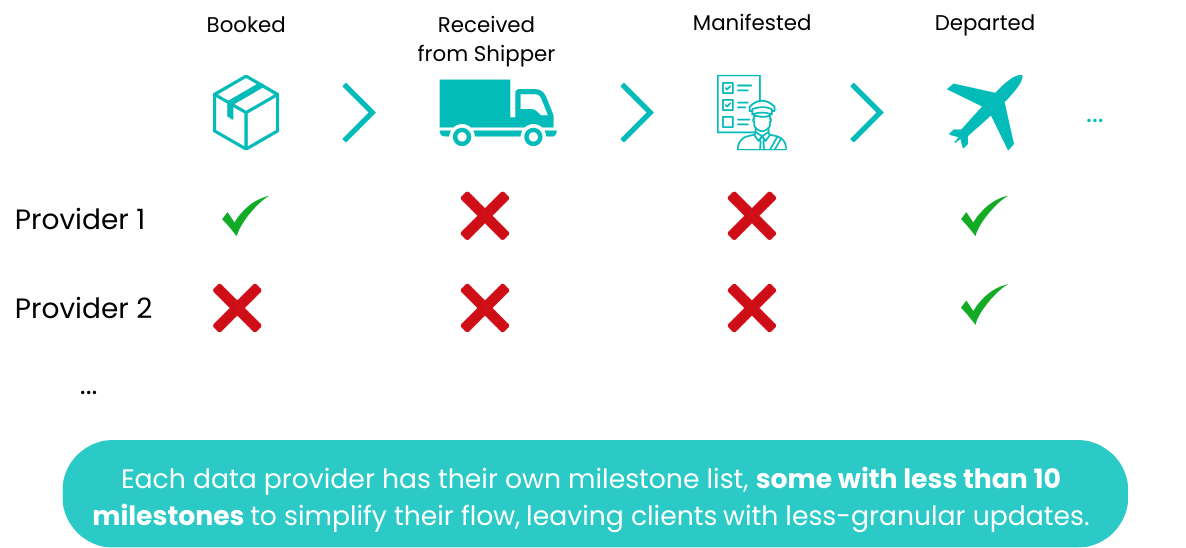
Unlocking Near Real-Time Visibility: The Role of Track and Trace APIs in Airfreight
As B2B customer expectations rise with the surge in next-day eCommerce deliveries, Track and Trace APIs have become one of the most impactful tools in the airfreight industry. In an increasingly competitive environment, shippers and logistics providers demand near real-time visibility into their shipments. Track and Trace APIs are at the heart of this evolution, enabling seamless tracking and driving greater operational efficiency.
In this blog, we will explore what Track and Trace APIs are, their diverse use cases, the logistics challenges they help overcome, and the enhanced tracking capabilities they bring to the airfreight sector. We will also cover the limitations of EDI and manual processes, as well as the importance of milestone granularity in shipment tracking.
Click here if you missed our blogs on Rate and Book APIs, Route and Schedule APIs and Sustainability APIs.
What are Track and Trace APIs in Airfreight?
Track and Trace APIs integrate tracking data into logistics platforms, providing stakeholders with quick and accurate updated shipment statuses. Unlike traditional methods like Electronic Data Interchange (EDI) or manual retrieval of updates, APIs pull data continuously from multiple sources—including airlines, ground handling agents (GHAs), customs brokers, and occasionally external partners. This architecture allows different systems to communicate seamlessly, making near real-time visibility accessible across platforms.
Track and Trace APIs are particularly crucial in airfreight, where shipments frequently pass through various locations and entities at any given time. Maintaining visibility throughout these transitions from origin to destination is essential for ensuring supply chain efficiency and reliability.
Important Note on "Real-Time":
When we refer to an update as "real-time" or "instant", it is essential to recognize that shipment updates in airfreight are rarely instantaneous. For this reason, we refer to them as "near real-time" in this blog. Given the complexity of different parties and systems involved, update delays occur, and this is known as latency.

Gone are the days of limited updates and 12 to 36-hour delays for status information; we are now moving toward the expectation of receiving accurate tracking updates within two hours or less. For a deeper dive into latency, you may refer to our previous blog on this topic.
The Importance of Track and Trace APIs: Challenges They Help Overcome
Traditionally, shipment tracking relied heavily on EDI-based communication, which was slow and error-prone. The need for modern tracking solutions arises from several key challenges:
- Fragmented Visibility: Information is often siloed across different stakeholders (airlines, ground handlers, etc.), leading to incomplete data. APIs consolidate these fragmented data streams, providing a unified, coherent tracking solution.
- Delayed Data: EDI systems process data in batches, meaning updates are shared at predefined intervals, sometimes hours or even days apart. APIs provide near real-time milestone updates, ensuring faster reactions to delays or disruptions.
- Coverage Gaps: Not all logistics carriers and players support EDIs, leaving gaps in terms of latency and visibility. APIs fill these gaps by pulling data from non-traditional sources such as cargo handlers and third-party providers, offering more comprehensive tracking.
- Meeting Customer Expectations: In today’s age of instant gratification heightened with the rise of eCommerce, Track and Trace APIs help logistics providers meet growing customer demands for real-time transparency, building trust and satisfaction.
Use Cases for Track and Trace APIs in Airfreight
Track and Trace APIs provide a range of benefits across different airfreight stakeholders:
- Embedded Status Monitoring: Freight forwarders and TMS providers can integrate near real-time shipment milestones, from booking confirmation to departure to final delivery directly into their systems, for a unified view of the shipment status across various logistics components from a single source of truth eliminating the need to visit multiple tracking sites.
- Proactive Issue Resolution: APIs offer near real-time notifications about disruptions, giving teams immediate visibility to make informed decisions like rerouting delayed shipments, thus minimizing potential impacts on customers.
- Performance Analytics and Reporting: Data from Track and Trace APIs can be analyzed to generate metrics and reports, such as delivery times, transit delays, and carrier performance, allowing companies to optimize operations and pinpoint bottlenecks.
- Consolidated Visibility: Data from airlines, ground handling agents, and customs authorities are aggregated, providing complete visibility across the entire supply chain.
While some level of tracking workflows already exists in airfreight, many operators still find themselves manually checking airline websites or making phone calls for updates. APIs digitize these workflows, reducing manual effort, allowing them to do higher leverage work, and offering additional value compared to EDI solutions, as discussed next.
Beyond EDI and Manual Checks: Why Modern Tracking Solutions Are Necessary
APIs enable faster, more accurate tracking than legacy systems like EDIs. More importantly, data coming from airlines through EDI is no longer the sole source of truth. Ground Handling Agents (GHAs), General Sales Agents (GSAs), and other stakeholders often have critical shipment data available to them earlier than the airlines, providing an edge to logistics providers leveraging these alternative sources.
For instance, GHAs may know and input when a shipment has been loaded onto a plane before the airline’s system is updated. Accessing this level of detail enhances supply chain agility and improves the customer experience.
Covering the Long-Tail of Shipments - A Growing Challenge
While major airlines have adopted EDI for tracking, a significant portion of airfreight is handled by smaller airlines and independent operators who may lack sophisticated tracking systems. This "long-tail" of shipments presents a major challenge for logistics providers aiming to achieve the 100% coverage that customers expect.
CargoAi’s Track and Trace API ensures that all shipments are tracked equally by combining data from a wide variety of sources—airlines, GHAs, GSAs, and third-party logistics providers. This allows Freight Forwarders and API users to achieve comprehensive visibility, even from smaller or niche operators.

Track and Trace APIs aim to provide comprehensive coverage:
- Data Aggregation: APIs collect information from diverse sources, covering a broader range of airlines.
- Alternative Data Sources: When EDI is unavailable, APIs turn to other methods for gathering tracking data.
- Standardization: APIs standardize data from different sources, offering a consistent user experience.
The Importance of Milestone Granularity
A key benchmark in shipment tracking is milestone granularity—the level of detail presented within the tracking events throughout the shipment lifecycle. Tracking information powered by APIs captures detailed milestones throughout the shipment lifecycle, from pickup to customs clearance and final delivery. This level of detail helps logistics providers make timely, informed decisions and manage issues proactively.

The level of detail in tracking milestones has become a benchmark for evaluating Track and Trace APIs:
- Standard Milestones: Basic APIs may only track and present major events such as when a shipment has departed or arrived.
- Enhanced Granularity: Advanced APIs offer more detail into tracking events, including customs clearance, warehouse movements, delivery statuses and more.
CargoAi’s CargoCONNECT Track and Trace API
CargoAi's mission is to provide seamless, one-stop tracking solutions, offering visibility for shipments as soon as they are confirmed. Our Track and Trace API stands out in the airfreight industry by providing access to and visibility of the largest airline & GHA portfolio, covering 190+ airlines, with 40+ exclusive to CargoAi. This comprehensive coverage allows for tracking up to 32 milestones throughout a shipment's journey.
Key features of CargoAi's Track and Trace API include:
- Comprehensive Coverage: Monitor the status of Air Cargo shipments across a vast network of airlines, ensuring wide-ranging visibility.
- Carbon Footprint Measurement: Along with tracking, the API allows users to measure the carbon footprint of their shipments, supporting sustainability initiatives.
- Tracking Subscription Service: For those who need to stay informed on critical milestones such as departure, arrival, and customs clearance, CargoAi offers a Tracking Subscription endpoint. This service pushes updates directly to a specified URL or email address, eliminating the need for constant API calls.
- Flexible Update Channels: Users can choose to receive updates via API URL (sent via POST), email, or both, allowing for integration into existing systems or workflows.
CargoAi's API provides unmatched visibility by aggregating data from airlines, GHAs, GSAs, and third-party logistics partners, ensuring comprehensive, near real-time tracking. This multi-source approach ensures that users are the earliest to be notified of any updates or changes in shipment statuses or milestones.
Would you like more information on our Track and Trace API and how it can benefit you and your business? Don't hesitate to book a quick call or a free demo with an expert from the CargoCONNECT team here.
Current Factors Affecting the Evolution of Track and Trace APIs
The rise of cloud computing has allowed logistics companies to store and process vast amounts of data, providing real-time access to shipment information from anywhere in the world. Artificial Intelligence (AI) is being used to analyze historical data and predict potential disruptions, giving logistics providers a proactive edge in mitigating delays. Internet of Things (IoT) technology, such as sensors on cargo containers, provides constant monitoring of environmental conditions like temperature and humidity, ensuring sensitive shipments remain secure. Blockchain technology ensures data security and transparency, creating an immutable record of every step in the shipment journey, which is crucial for building trust and compliance.
CargoAi leverages these advancements by integrating AI-powered data analytics and cloud-based architecture within our CargoCONNECT API suite, providing enriched, real-time insights and predictive tracking capabilities that go beyond traditional shipment visibility.
Conclusion
As customer expectations rise, near real-time visibility in airfreight is no longer a luxury—it’s a necessity. Track and Trace APIs have become essential tools for logistics providers, enabling them to overcome the limitations of traditional EDI systems and manual tracking processes. By offering enhanced visibility, milestone granularity, and comprehensive coverage, these APIs empower freight forwarders and shippers to make informed decisions and deliver exceptional service. CargoAi’s CargoCONNECT Track and Trace API leads the charge by providing enriched, real-time tracking that goes beyond the status quo, ensuring smooth operations and exceeding customer demands.
Stay tuned for our next week's blog that will help put things together, understanding if API Integrations are for you and get a quick guide on how to start integrating.
For more information about CargoCONNECT, CargoAi’s API suite, download our brochure or contact our Support team.